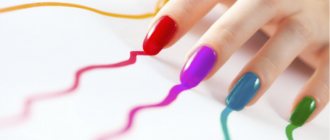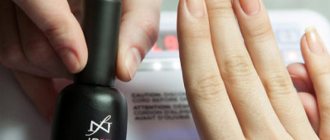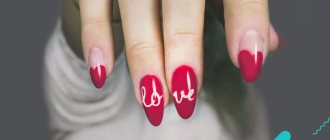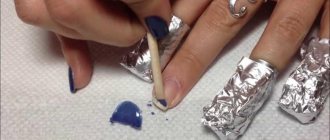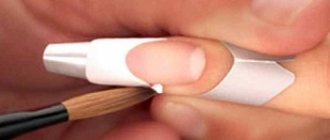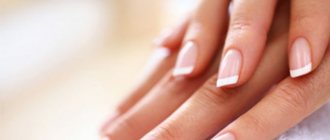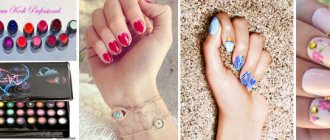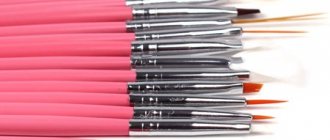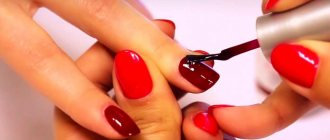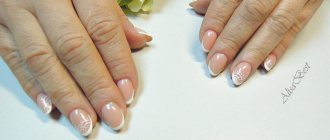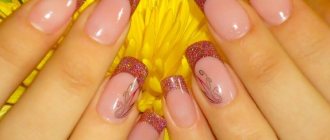Beautiful and durable long nails are what every woman dreams of. Often fashionistas resort to such a complex and controversial procedure as extensions. Not only is it quite expensive and complex, such an acrylic or gel manicure also requires correction. A separate difficulty is removing extended acrylic or gel nails at home. And girls do this work on their own quite often, trying to save on salon services.
[yandex1] [google1]
Why get nail extensions?
Nails after extensions are good because they decorate and literally transform a lady’s hand. It is very convenient to be the owner of beautiful nails, and at the same time not to spend a lot of time on manicure.
Therefore, many women rush to salons to get their nails done. And always after this procedure, almost every woman has a question: how to restore nails after extensions?
Modern opportunities in beauty salons make it possible to transform brittle and weak nails into beautiful and well-groomed nails.
It is not always possible to extend nails with gel. It is worth noting that after its removal, the nails require even more restorative care.
If you are interested in the question: how to restore nails after extensions at home, then you can answer this: daily care will help restore strength and strength to your manicure.
Baths and masks
Nail plates benefit greatly from sea salt baths, which should preferably be used daily. To do this, stir a few tablespoons of salt in warm water and add three drops of lemon juice or aromatic oil. Keep your fingers in the liquid for about fifteen minutes. When the time is up, wipe your hands dry, massage your nails by dropping sunflower, olive, sea buckthorn or peach oils on them.
Baths with vegetable oil are also effective. To do this, warm it slightly, add three drops of lemon juice and keep your fingers in the mixture for about fifteen to twenty minutes. After removing your fingers from the mixture, do a massage, which promotes blood circulation and will have a positive effect on your nails.
Baths of sour berries quickly restore nail plates at home: you need to make a paste out of them, apply them to your nails or dip your fingers in a bowl with berries. Keep for at least ten minutes. After this, wash your hands; if your fingers are stained and the paint does not wash off, you can leave it: in a day or two it will come off on its own. Wipe your hands and apply nourishing cream.
Potatoes help tidy up your nails. It contains starch and various microelements, with which you can effectively and quickly treat nail plates.
To do this, boil the potatoes, mash them and apply them to your nails. The puree should be very warm, but not hot, so as not to burn your fingers. After this, put plastic bags on your hands (you can stock up on cellophane gloves in advance) and wrap them in a towel. Leave the potatoes until they have cooled completely, then rinse and apply hand cream.
Also, instead of potatoes, you can use the water in which they were boiled. To do this, dip your fingers in the warm liquid and hold until it cools (fifteen to twenty minutes).
Why are restoration procedures necessary after extensions?
Nail extensions artificially increase the length of the nail. The main goal of this process is to eliminate existing problems of the nail plate.
We list these defects:
- Weakness of the nail plate;
- Its fragility;
- Peeling of the nail;
- Nail problems due to various types of injuries.
The polymerization reaction is the basis of extension technology. The principle is that ultraviolet rays help harden the material.
When extending the nail plate, it is possible to use silk, tips, glue-powder, paper or plastic forms for nail extension.
Extension technique step by step
Extending nails with gel polish onto tips and forms has the same goal, but the process itself is slightly different.
For tips
Step-by-step instruction:
- Hands are treated with an antiseptic, cuticles are removed, excess length of nails is filed off, and the top, thinnest layer of the plate is removed.
- The tips are selected according to size, glued to the nails and pressed for a while to remove all the bubbles, then dry.
- The tips are given the required shape and length using a nail file. The surface is degreased, modeling gel is applied in 2 layers, after each of which drying in a UV lamp is required.
- The sticky layer is removed, the nails are filed to remove all possible irregularities.
- The extended nail is coated with colored gel polish (optional), a manicure design is created with gel polish, or left as is, covering the nails with a finish and drying.
Step-by-step manicure using tips
On forms
Extension of artificial nail plates with forms comes in two types: lower and upper. In the first case, the form is placed under the nail, in the second - on it, along the growth line. In both options, the extended nail turns out smooth and beautiful.
Step-by-step instruction:
- A full manicure is carried out, as in the first case: cuticles are removed, the length of the nails is removed, the top layer is polished. Cover the nails with primer and wait until it dries on its own.
- The form is applied under or on the nail, using a brush, modeling gel polish is laid out and evenly distributed in the middle of the nail, after which the first layer must be dried in a lamp.
- To strengthen the nail plate, apply a second layer, spread evenly and dry.
- There may be irregularities left on the artificial plates, which are filed down, excess length is removed and the nails are given the required shape.
- A design is made on the nail plates, which the client has chosen in advance, colored gel polishes, drawings, rhinestones, stickers, etc. are applied.
- Finally, the nails are coated with a finish.
Step-by-step manicure on forms
Modeling nail plates using forms
When carrying out the nail extension procedure, a gel is applied to it, and under the influence of ultraviolet rays it hardens.
Before carrying out this procedure, the master is obliged to familiarize the client with its nuances. After all, extensions can have a bad effect on human health, because the gel blocks the access of oxygen to the tissues.
We recommend reading:
Cuticle removal - tips on choosing products and an overview of the best removal methods. 130 photos and videos of cuticle care- Beauty salon Persona-Mayakovskaya
- How to restore nails after gel polish - a review of the best means and methods of restoration at home (120 photos + video master class)
Women should always be interested in the question of how to strengthen their nails after extensions.
Is it true that the gel is very harmful, its properties
Light-curing gel is considered one of the most popular materials for creating artificial nails. This gel hardens under UV rays, which in small doses do not harm human health at all.
Gel is a synthetic substance, the consistency of which may vary. It contains pine needle-based polymers and methacrylic acid derivatives. Unlike acrylic, gel is ready for use.
Advantages of the gel:
- Self-levels well;
- Has a glossy surface;
- Bactericidal properties;
- Elasticity;
- Transparency;
- The material is breathable;
- Protect and strengthen the nail.
Disadvantages of extension material:
- Unlike acrylic, it is fragile;
- Correction of nails after extensions will force the material to be cut down;
- Not easy to remove;
- Do not adjust frequently, otherwise small burns and other damage may occur.
About the design of extended nails
Features and trends
Extension methods are constantly updated and improved. Modern masters usually use modeling using forms or tips. In order to extend nails, durable acrylic or gel is used, which has a more natural look.
Plate modeling solves several problems at once. Many people mistakenly think that extensions are only necessary to lengthen nails. However, this technique has many other advantages:
- Nails become denser and stronger thanks to the structure of the artificial coating.
- The plates look very smooth and perfectly maintained.
- The owner of a manicure can independently choose the length of her nails, regardless of their size and thickness.
- The ability to choose the ideal shape of the plates, as well as change it during a new modeling.
- Extended nails are an excellent basis for a complex design with an abundance of elements.
- Any design details can be easily attached to artificial turf.
- Any design on extended nails looks more presentable and stylish than on natural plates.
- Manicure lasts longer if its design is applied to a gel or acrylic base.
It is thanks to the versatility of extended nails to suit any type of decor that most women resort to modeling plates.
Trendy shades
Many interesting color schemes are used for extended nails. Among fashionable shades, both bright and rich tones and delicate light coatings are popular. The following options are considered the most trendy colors this season:
- Red. The most preferred are scarlet, ruby, raspberry, burgundy and garnet shades.
- Blue. In addition to the pure heavenly color, azure, pale cornflower blue, turquoise and various pastel shades of blue are distinguished.
- Yellow. Bold and decisive color gives fashionable finishes in lemon, mustard, amber and honey shades.
- Pink. This tone includes both light nude colors and a bright palette. Among the most stylish solutions, peach, salmon, pale raspberry and light fuchsia are in demand.
- White. Fashionable shades are snow-white, milky and ivory.
- Orange. Many people like this tone for its excellent compatibility with dark designs, as well as with other bright varnishes. Coral and pumpkin shades look very attractive.
- Violet. This color is considered more appropriate for extended nails than blue. Plum, lilac, purple and indigo shades look original.
Varieties of forms
The type of extended nails is selected taking into account the characteristics of natural plates or according to the client’s personal preference. When performing a manicure, much attention is paid to the shape of the nails, since the choice of a specific design depends on it. Among the many varieties, these forms look especially beautiful:
- Oval - has rounded tips and visually lengthens the nails.
- Square - characterized by a straight tip with pointed corners, suitable for owners of narrow plates.
- Soft square - straight free edge with slightly rounded tips.
- Almond-shaped - cone-shaped tips.
- Pointe shoes have a square tip on almond-shaped nails.
Theme and style
Designs for extended nails can have a very different focus and theme. Many people choose their everyday decor based on their style and interests. If you have to attend any event, then take into account the reason for the upcoming event.
Floral and plant themes are always popular. Animal prints, inscriptions and openwork patterns look beautiful. In summer, the rainbow theme is especially relevant, as well as light decor based on nudes.
The wedding style is especially worth highlighting. This is where nail modeling is often used with a beautiful original design, including subtle designs, elegant French, as well as complex designs.
For more informal celebrations, mixing styles and themes is acceptable. Extended nails are an excellent basis for colorful coatings and abundant decoration.
After nail extensions - infections
If a manicurist uses unsterile tools when working, this can lead to various infections that will harm the natural nail.
If the acrylic or gel layer on the nail is damaged, a small air bubble appears, then an environment for the proliferation of microorganisms and pathogenic fungi is almost automatically created. In such a situation, you should clean the damaged nail, otherwise more serious problems may occur.
If your nails hurt after extensions, you should first contact a manicurist, and then maybe a doctor.
Remember, any extension of the nail plate leads to its weakening, increasing the chances of infections and fungus.
If the fungus is not treated promptly, you can lose your natural nail and possibly damage the soft tissues of your hand. An infection such as a fungus takes an average of six months to cure.
Myths about extensions
Myth No. 1
The extension procedure spoils the condition of the nail plates. They can only deteriorate from infections or damage caused by an inexperienced technician during extensions or while removing materials from the nail plates. It is quite possible to get an infection if your manicurist does not properly treat the tools. Also, before any manipulation with your hands, a real professional will always treat them with a special hygienic solution.
Myth No. 2
Artificial materials ruin your nails. The two main materials that are most often used for extensions are gel and acrylic. Both materials were borrowed from dentists. And, accordingly, they cannot be harmful in themselves. Damage to your nails can be caused by a manicurist who has not mastered his craft well, or by you yourself if you decide to remove the extended nails yourself.
Myth No. 3
Fungal bacteria and mold grow from gel and acrylic. If basic hygiene rules are not followed, the fungus can also be acquired during a regular manicure. Sometimes your own nails can reject artificial materials. In this case, a space forms between the nail and the coating, where water or other substances enter. This can cause fungus to appear.
Myth No. 4
Gel and acrylic cause allergies. This is not true at all. Allergic reactions can be caused by “sawdust” during removal of the gel or from the dispersion layer of the gel. Materials such as gel and acrylic are completely hypoallergenic.
Myth No. 5
Nails do not breathe under a layer of gel or acrylic. During extension, artificial materials are applied to dead matrix cells. These keratinized cells are the basis of the structure of the nail plate. To ensure that your nails receive enough nutrition under the gel layer, you need to use cuticle products and also take a multivitamin complex.
How to care for your nails after extensions
After nail extensions, do not forget to consult with a manicurist, he will prescribe medications and good treatment procedures to care for the manicure and your new nails. The specialist will answer your questions in detail.
For the first time these days, you need to treat your hands with more special care. Only after a thorough assessment of the condition of the nails can the necessary prevention or treatment be undertaken.
All care products should include the following substances:
- glycerol;
- aloe;
- peach oil;
- lemon;
- vitamin E.
Therapeutic varnishes for restoration
Healing varnishes are the best alternative to cosmetics that contain acetone. After all, they are the ones who restore damaged and brittle nails well.
Doctors often advise using these products as a preventive measure, and even as a treatment for a diseased nail.
We cannot neglect the health of our hands and nails; everything in our body is interconnected.
Hands reflect our well-being and condition.
Photos of nails after extensions
Please repost
1+
